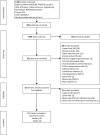A Systematic Review of Paired Associative Stimulation (PAS) to Modulate Lower Limb Corticomotor Excitability: Implications for Stimulation Parameter Selection and Experimental Design
- PMID: 31507367
- PMCID: PMC6718871
- DOI: 10.3389/fnins.2019.00895
A Systematic Review of Paired Associative Stimulation (PAS) to Modulate Lower Limb Corticomotor Excitability: Implications for Stimulation Parameter Selection and Experimental Design
Abstract
Non-invasive neuromodulatory interventions have the potential to influence neural plasticity and augment motor rehabilitation in people with stroke. Paired associative stimulation (PAS) involves the repeated pairing of single pulses of electrical stimulation to a peripheral nerve and single pulses of transcranial magnetic stimulation over the contralateral primary motor cortex. Efficacy of PAS in the lower limb of healthy and stroke populations has not been systematically appraised. Optimal protocols including stimulation parameter settings have yet to be determined. This systematic review (a) examines the efficacy of PAS on lower limb corticomotor excitability in healthy and stroke populations and (b) evaluates the stimulation parameters employed. Five databases were searched for randomized, non-randomized, and pre-post experimental studies evaluating lower limb PAS in healthy and stroke populations. Two independent reviewers identified eligible studies and assessed methodological quality using a modified Downs and Blacks Tool and the TMS Checklist. Intervention stimulation parameters and TMS measurement details were also extracted and compared. Twelve articles, comprising 24 experiments, met the inclusion criteria. Four articles evaluated PAS in people with stroke. Following a single session of PAS, 21 experiments reported modulation of corticomotor excitability, lasting up to 60 min; however, the research lacked methodological rigor. Intervention stimulation parameters were highly variable across experiments, and whilst these appeared to influence efficacy, variations in the intervention and outcome assessment methods hindered the ability to draw conclusions about optimal parameters. Lower limb PAS research requires further investigation before considering its translation into clinical practice. Eight key recommendations serve as guide for enhancing future research in the field.
Keywords: STDP; cortical excitability; neuronal plasticity (MeSH); paired associative stimulation; primary motor cortex; rehabilitation (MeSH); stroke (MeSH); transcranial magnetic stimulation.
Similar articles
-
Paired associative stimulation modulates corticomotor excitability in chronic stroke: A preliminary investigation.Restor Neurol Neurosci. 2018;36(2):183-194. doi: 10.3233/RNN-170785. Restor Neurol Neurosci. 2018. PMID: 29526858 Free PMC article.
-
Contralesional paired associative stimulation increases paretic lower limb motor excitability post-stroke.Exp Brain Res. 2008 Mar;185(4):563-70. doi: 10.1007/s00221-007-1183-x. Epub 2007 Nov 1. Exp Brain Res. 2008. PMID: 17973101
-
Paired Associative Stimulation Delivered by Pairing Movement-Related Cortical Potentials With Peripheral Electrical Stimulation: An Investigation of the Duration of Neuromodulatory Effects.Neuromodulation. 2018 Jun;21(4):362-367. doi: 10.1111/ner.12616. Epub 2017 Jun 5. Neuromodulation. 2018. PMID: 28580648
-
The Effectiveness of Paired Associative Stimulation on Motor Recovery after Stroke: A Scoping Review.Neurol Int. 2024 May 14;16(3):567-589. doi: 10.3390/neurolint16030043. Neurol Int. 2024. PMID: 38804482 Free PMC article.
-
Efficacy and time course of paired associative stimulation in cortical plasticity: Implications for neuropsychiatry.Clin Neurophysiol. 2016 Jan;127(1):732-739. doi: 10.1016/j.clinph.2015.04.072. Epub 2015 May 8. Clin Neurophysiol. 2016. PMID: 26024981 Review.
Cited by
-
Intra- and Inter-Rater Reliability of Manual Feature Extraction Methods in Movement Related Cortical Potential Analysis.Sensors (Basel). 2020 Apr 24;20(8):2427. doi: 10.3390/s20082427. Sensors (Basel). 2020. PMID: 32344692 Free PMC article.
-
Induction of Neural Plasticity Using a Low-Cost Open Source Brain-Computer Interface and a 3D-Printed Wrist Exoskeleton.Sensors (Basel). 2021 Jan 15;21(2):572. doi: 10.3390/s21020572. Sensors (Basel). 2021. PMID: 33467420 Free PMC article.
-
Electroencephalographic responses before, during, and after upper limb paired associative stimulation.Data Brief. 2025 Mar 15;60:111467. doi: 10.1016/j.dib.2025.111467. eCollection 2025 Jun. Data Brief. 2025. PMID: 40226202 Free PMC article.
-
Investigating the Intervention Parameters of Endogenous Paired Associative Stimulation (ePAS).Brain Sci. 2021 Feb 12;11(2):224. doi: 10.3390/brainsci11020224. Brain Sci. 2021. PMID: 33673171 Free PMC article.
-
Exploring the potential of combining transcranial magnetic stimulation and electroencephalography to investigate mild cognitive impairment and Alzheimer's disease: a systematic review.Geroscience. 2024 Aug;46(4):3659-3693. doi: 10.1007/s11357-024-01075-6. Epub 2024 Feb 15. Geroscience. 2024. PMID: 38356029 Free PMC article.
References
-
- Aymard C., Katz R., Lafitte C., Lo E., Pénicaud A., Pradat-Diehl P., et al. . (2000). Presynaptic inhibition and homosynaptic depression: a comparison between lower and upper limbs in normal human subjects and patients with hemiplegia. Brain 123(Pt 8), 1688–1702. 10.1093/brain/123.8.1688 - DOI - PubMed
-
- Bashir S., Perez J. M., Horvath J. C., Pena-Gomez C., Vernet M., Capia A., et al. . (2014). Differential effects of motor cortical excitability and plasticity in young and old individuals: a Transcranial Magnetic Stimulation (TMS) study. Front. Aging Neurosci. 6:111. 10.3389/fnagi.2014.00111 - DOI - PMC - PubMed
-
- Bastani A., Jaberzadeh S. (2012). Does anodal transcranial direct current stimulation enhance excitability of the motor cortex and motor function in healthy individuals and subjects with stroke: a systematic review and meta-analysis. Clin. Neurophysiol. 123, 644–657. 10.1016/j.clinph.2011.08.029 - DOI - PubMed
Publication types
LinkOut - more resources
Full Text Sources
Miscellaneous


